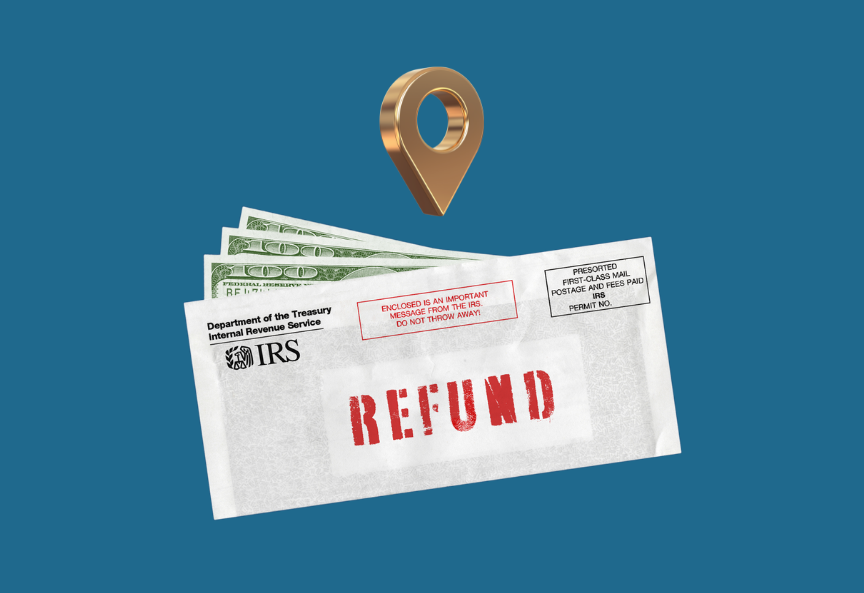While roughly a third of Americans don’t know whether to expect tax debt or a tax refund, nearly half of surveyed taxpaying Americans expect a tax refund at the end of the tax year. The IRS claims that as many as 75 percent of taxpayers overpay. Tax refunds can range from a few dollars to thousands of dollars, with the average federal tax refund in 2019 being $3,163. That is a lot of money, and, understandably, most taxpayers anxiously follow their IRS tax refund status. But refund payouts aren’t immediate. It can take a few weeks for the IRS to process your refunds and another five to ten days for your bank to clear the deposit or for the postal service to mail your check. Thankfully, the IRS enables taxpayers to keep a close eye on their refund payday via the official IRS website.
Tracking Your IRS Tax Refund Status
The easiest and most convenient way to check your federal tax refund status is online. All you need to check when your refund will arrive is:
- Your social security number OR,
- Your taxpayer identification number,
- Your filing status,
- Your exact refund amount.
You can also check your refund by logging into your IRS tax account on a web browser or logging into your tax account via the IRS2Go app. If you do not know your exact refund amount, use the Refund Amount calculated and indicated on your last tax return. Once you’ve input the proper credentials and information, the IRS will display the status of your tax refund for the most recent tax year that you’re on file. The details on your refund status are updated daily. Still, it takes 24 hours for an electronic tax return to be processed and up to four weeks for a mail-in paper tax return. If you would like to contact a human at the IRS, it is in your best interest to do so at least 21 days after you’ve e-filed or when your refund status report (i.e., the Where’s My Refund tool) tells you to contact the IRS. If you’ve filed a paper return, you will want to count on waiting at least eight weeks before contacting the IRS about your tax refund.
Tax Credit Claimants and Other Delays
Some tax returns take longer to process than others, which can affect and add to the time you might be waiting on your tax refund. If you’ve claimed the Earned Income Tax Credit or the Additional Child Tax Credit, the IRS cannot issue your tax refund until March 1, provided you filed online and choose to get your refund via direct deposit. You will have to count on another four weeks and five days if you sent your tax return in via mail and opted to receive a check via the postal service. Other tax return details which can result in a longer-than-usual wait period include:
- A correction is needed for your Child Tax Credit amount.
- A modification is required for your Recovery Rebate Credit amount.
- Your tax return is incomplete.
- You have become a victim of identity theft or fraud.
- You have included Form 8379 (Injured Spouse Allocation), which can add 14 weeks of processing.
If you are due a tax refund but need to amend your tax return, wait until you have received your tax refund. The IRS recommends sending in your amended return, or a Form 1040-X, after your tax refund has been sent to you.
Tips to Speed Up Your IRS Tax Refund
Tax refunds can take four to eight weeks to be sent to you after filing your return, and longer under certain circumstances. Here’s how you can minimize your wait times:
- File electronically.
- Opt for a direct deposit into a bank account of your choice.
- Start tracking your refund a day after filing it.
- Contact the IRS if your refund is taking longer than 21 days.
What a Big Tax Refund Tells You
A hefty tax refund indicates overpaying and means you’ve been giving the government money you could’ve used when you needed it. If we round down the average federal tax refund to $3,000, an additional $250 a month that the average taxpayer would have had in their pocket. While it is a good idea to stay on the IRS’s good side and avoid needlessly slipping into tax debt – and the penalties it brings – you should consider adjusting your withholding via Form W-4 if your tax refunds are consistently considerable. On the other hand, keeping your refund high and letting the IRS send it straight into a savings or retirement account can keep you from spending money you might not need to spend and gives you a guaranteed annual source of retirement or investment funds.
Choosing What Account the IRS Should Refund To
If you’d like to save your federal tax refund or even put it towards your retirement savings, you can specify the account the IRS will send money to via a Form 1040 or 1040-SR. A Form-8888 (Allocation of Refund) even allows you to tell the IRS to split the money among three different accounts.
What if I Owe the IRS Money, Instead?
If you’ve underpaid rather than overpaid, the IRS will send you a Notice of Due Balance after making the appropriate tax assessment. There will be a deadline for your due payment on the notice, and failing to pay by the said deadline may invoke a penalty for failure to pay at a rate of 0.5 percent of your tax debt per month. Ignoring the IRS can lead to more stringent collection actions and a steeper cost.
Dealing with the IRS can be difficult, whether you’ve overpaid or underpaid. Minimize your tax-related headaches by working with qualified tax professionals. We at Rush Tax Resolution can aid with all of your tax relief-related needs and help you stay on the IRS’s good side.

